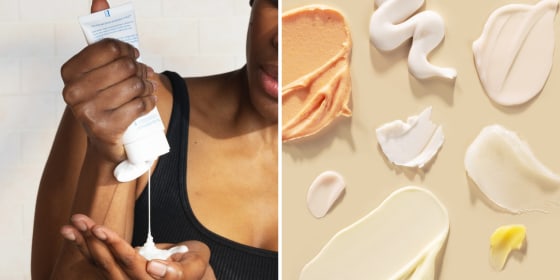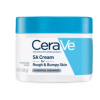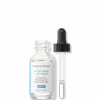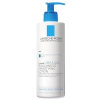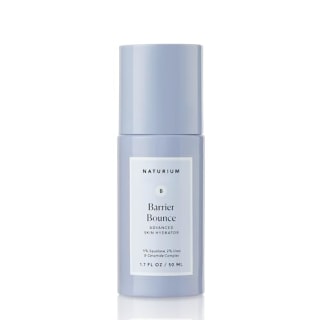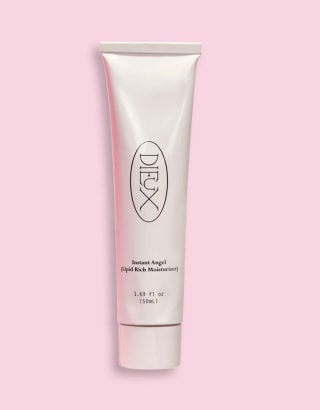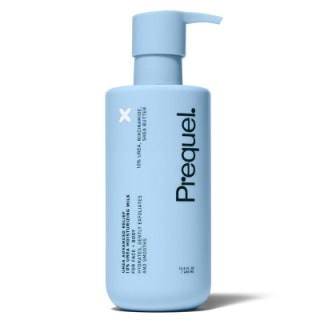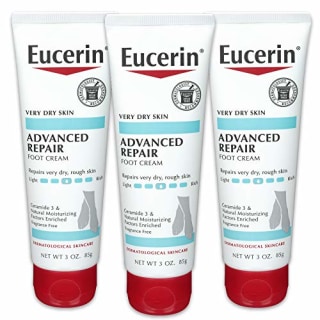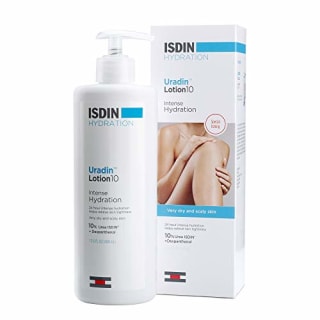Urea isn’t the sexiest skin care ingredient out there — it’s been a mainstay in body lotions and foot creams for years — but recently, it’s blown up on social media. If you have rough patches, stubborn dryness or certain skin conditions like keratosis pilaris, it’s worth considering incorporating it into your skin care routine. Unlike most ingredients, it works to both smooth (ie: exfoliate) and hydrate skin.
For the unfamiliar, “urea is a naturally occurring compound found in the skin that plays a key role in maintaining hydration,” says Dr. Amy Spizuoco, a board-certified dermatologist in New York City. “In skin care, it’s a powerful humectant and keratolytic agent, meaning it helps attract moisture and gently exfoliates the skin.” That’s what gives it the ability to moisturize your face and treat dry, cracked skin. Here’s how to make the most out of the versatile ingredient.
SKIP AHEAD How I picked the best urea skin-care products | The best urea skin-care products in 2025 | How to shop for urea skin-care products | Frequently asked questions | Why trust NBC Select?
What are urea’s skin-care benefits?
Urea has quite a few skin-care benefits. For one, “urea is a humectant, meaning it draws water into the skin to help combat dryness,” says Spizuoco.
At higher concentrations, it becomes a keratolytic agent, meaning “it softens and breaks down dead skin cells, making it effective for rough, calloused skin,” says Spizuoco, who notes that this also enhances the penetration of other active ingredients.
Finally, “urea can enhance the skin barrier by supporting the top layer of the skin, the stratum corneum,” says Hanson. “By strengthening the barrier of the skin, this helps to protect against irritants and harmful environmental triggers.”
How I picked the best urea skin care products
To create this list, I first reached out to three dermatologists, who shared their favorite skin care products with urea. Based on their advice, I then looked for products that had attributes that they recommended, which included:
- Complementary ingredients: Urea’s multitasking nature means that it works well alongside other hydrating ingredients — or can be useful when paired with exfoliating agents.
- Concentration: The concentration of urea can range from 2% to 40%; the higher you go, the more exfoliating it can be. Therefore, this can affect where and how you use it. For instance, facial products typically max out at a 10% concentration of urea, since the skin is more delicate.
- Fragrance-free: Because urea can be potentially irritating at high concentrations, our experts recommended avoiding combining it with fragrance (a common irritant).
- Area of usage: A urea product meant for your feet will be much different (and probably too powerful) for your face, so it’s important to consider whether it will be used for your face or body.
Want more from NBC Select? Sign up for our newsletter, The Selection, and shop smarter.
The best urea skin care products in 2025
Best face serum: Naturium Barrier Bounce Advanced Skin Hydrator
- Suits all skin types
- Affordable
- Dewy finish
- Potentially clogs pores
This bi-phase serum — meaning it pairs oils with water-based ingredients — sets out to support the skin barrier with a combination of jojoba oil, glycerin and other moisturizers. Chicago, IL-based board-certified dermatologist Dr. Omer Ibrahim likes that by combining a low percentage of urea with squalane and ceramides — which help support the skin barrier — you can use the formula “as a serum under a richer-textured cream for those with dry skin, or as a lone hydrator for those with more oily skin,” he says.
Other ingredients: Jojoba seed oil, glycerin, ceramides, squalane | Concentration: 2% | Fragrance-free: Yes
Best face moisturizer: Dieux Skin Instant Angel Moisturizer
- Safe for sensitive skin
- Supports skin barrier
- Potentially clogs pores
One of the 100 best face moisturizers of 2025, this cream is designed to support and protect the skin barrier. It has a 3% moisture complex made up of glycerin, sodium hyaluronate (a form of hyaluronic acid) and urea, although the brand doesn’t disclose the exact concentration of urea. It also has a slew of other ingredients that will make your skin happy: peptides, ceramides and fatty acids, which should help repair the skin’s moisture barrier to keep it calm and comfortable, according to the brand.
Other ingredients: Glycerin, sodium hyaluronate, peptides | Concentration: Not listed | Fragrance-free: Yes
Best face moisturizer for eczema: Prequel Urea Advanced Relief Moisturizing Milk
- Non-comedogenic
- Safe for sensitive skin
- Not greasy
- Can lead to pilling
This moisturizer is intended for both face and body. It has a 10% concentration of urea that is relatively high for the facial skin — but also gives it the ability to smooth and soothe rough or flaky patches. (Even so, the brand says that it’s still gentle enough for eczema- and psoriasis-prone skin.) It also has shea butter, glycerin and niacinamide and can even help skin-care products better absorb into skin, according to the brand.
Other ingredients: shea butter, glycerin, niacinamide | Concentration: 10% | Fragrance-free: yes
Best serum for sensitive skin: SkinCeuticals Retexturing Activator
- Safe for sensitive skin
- Absorbs quickly
- Hydrates skin
- Expensive
This lightweight serum combines a urea complex as well as hyaluronic acid and kombucha (which is thought to brighten skin), which together allow it to gently smooth skin texture and brighten skin, according to the brand. For that reason, “it’s a great exfoliator for those with more sensitive and dry skin,” says Ibrahim. The oil-free formula also helps balance moisture in the skin. Also worth noting: While the concentration of the urea complex is at 25%, it comprises both urea and aminosulfonic acid, so the exact level of urea is most likely lower than that.
Other ingredients: Kombucha, hyaluronic acid | Concentration: Not listed | Fragrance-free: Yes
Urea Body Products
Best body lotion for those with keratosis pilaris: CeraVe SA Cream for Rough & Bumpy Skin
- Affordable
- Suits all skin types
- Works for face and body
- Nothing at this time
Intended to soften and smooth skin, Cerave’s SA Cream for Rough & Bumpy Skin pairs urea with the titular salicylic acid and lactic acid, which together “provide great exfoliation but also helps to hydrate the skin and calm any inflammation,” says Dr. Miriam Hanson, a board-certified dermatologist in Austin, Texas. That makes it a great option if you’re dealing with keratosis pilaris, rough patches, or uneven skin texture, according to Spizuoco. It’s also fragrance-free and won’t clog pores, making it mild enough for more sensitive skin types.
Other ingredients: Salicylic acid, lactic acid, ceramides, glycerin | Concentration: 10% | Fragrance-free: Yes
Best body lotion for sensitive skin: La Roche-Posay Lipikar Urea 10% Roughness Smoothing Lotion
- Non-sticky
- Affordable
- Daily usage
- Nothing at this time
A hallmark of inflammatory skin conditions — like eczema, psoriasis, and keratosis pilaris — is dry, sensitive skin. But the La Roche-Posay Lipikar Urea 10% Roughness Smoothing Lotion is a safe bet, according to Ibrahim; he calls it “a tried-and-true body lotion that is fantastic for those with sensitive skin.” Plus, he says, you can use it long-term to soften skin and remove bumps and uneven texture.
Other ingredients: Shea butter, allantoin | Concentration: 10% | Fragrance-free: Yes
Best foot cream: Eucerin Advanced Repair Foot Cream
- Fast-absorbing
- Exfoliates
- Affordable
- Urea amount isn’t shared
Hanson says that this a great pick for anyone with dry cracked heels, since its 10% urea in combination with ingredients like lactic acid, glycerin, shea butter and ceramides work together to exfoliate the skin while also still locking in moisture and helping to repair the natural skin barrier. It’s non-greasy and fast absorbing, according to the brand, so you don’t have to worry about slipping.
Other ingredients: Lactic acid, ceramides, glycerin, shea butter | Concentration: Not listed | Fragrance-free: Yes
Best for those with diabetes: CeraVe Diabetics Dry Skin Relief Moisturizing Cream
- Absorbs quickly
- Suits sensitive skin
- Urea amount isn’t shared
Diabetes can lead to dry, itchy skin, according to the Centers for Disease Control, since high blood sugar causes dehydration and contributes to poor circulation. That’s where this cream may be helpful. Formulated specifically for those with diabetes, this cream has ceramides and other anti-inflammatory antioxidants that help repair skin barrier, says Ibrahim, who also likes that it’s gentle and absorbs quickly.
Other ingredients: Ceramides, glycerin | Concentration: Not listed | Fragrance-free: Yes
Best nongreasy body lotion: Isdin Ureadin Lotion 10
- Relieves itch
- Daily usage
- Lightweight
- Has fragrance
Formulated to relieve itchiness, this body lotion has 10% urea with 3% dexpanthenol, a moisturizing ingredient that should help further keep your skin hydrated. Spizuoco likes that it’s lightweight and absorbs quickly, and notes that it “hydrates and smooths without feeling greasy, making it ideal for daily body care,” she says. The formula also has emollients, another hydrating ingredient, to help smooth the skin out, according to the brand.
Other ingredients: dexpanthenol, avocado oil, glycerin | Concentration: 10% | Fragrance-free: no
How to shop for skin care products with urea
If you want to incorporate urea into your routine, start by looking at the concentration. The concentrations can span from 2% to as high as 40% — and they can go even higher with a prescription from your doctor. In general, here’s how they differ, according to Spizuoco:
- Low concentrations (2-10%): This range is ideal for general hydration and mild dryness on the face or body. It works for most skin types, too, including sensitive skin.
- Medium Concentrations (10-20%): At these levels, urea can help smooth rough, scaly patches on the body, especially if they’re caused by conditions like keratosis pilaris.
- High Concentrations (30-40%): This much urea has a strong keratolytic effect (meaning they break down excess skin or tissue), making it ideal for tackling thickened skin, calluses and severe dry patches on the body, like those on the feet.
Then, look for a formula that pairs urea with complementary ingredients, depending on your concern. If you’re dealing with dryness, Spizuoco recommends ingredients that boost hydration and barrier repair, such as hyaluronic acid, glycerin and ceramides. This works especially well when you’re using urea at low concentrations for either the face or body. “While urea draws moisture to the skin, hyaluronic acid and glycerin help to retain that moisture,” says Hanson. Ceramides are similarly strategic; they’re “especially helpful in dry or compromised skin, as ceramides work alongside urea to lock in moisture,” she says.
If you’re seeking exfoliation, consider pairing a medium concentration of urea with exfoliating acids. “These ingredients may work synergistically with urea to treat thicker, dry patches or bumpy skin,” says Hanson, who likes alpha hydroxy acids, such as lactic acid or glycolic acid, as well as salicylic acid.
Finally, try to avoid fragrance if possible, especially if you’re opting for medium or high concentrations. “Urea can be slightly irritating, so fragrance-free products are best for sensitive skin,” says Spizuoco.
Meet our experts
At NBC Select, we work with experts who have specialized knowledge and authority based on relevant training and/or experience. We also take steps to ensure all expert advice and recommendations are made independently and without undisclosed financial conflicts of interest.
- Dr. Amy Spizuoco, FAOCD, is a board-certified dermatologist and dermatopathologist in New York, NY. She’s the president of the American Osteopathic College of Dermatology and a professor of dermatology at the Icahn School of Medicine at Mount Sinai, also in New York.
- Dr. Omer Ibrahim, FAAD, is a board-certified dermatologist in Chicago, IL. He’s the co-director of Chicago Cosmetic and Dermatologic Research and has a special interest in both hair loss and laser- and light-based treatments.
- Dr. Miriam Hanson is a board-certified dermatologist in Austin, TX. She specializes in pairing aesthetic skin-care with cosmetic and general dermatology.
Why trust NBC Select?
I’m a freelance beauty writer and editor who’s been covering beauty and health for more than a decade, including topics like retinol body lotions and prebiotic skin care. For this article, I spoke to three dermatologists to narrow down the urea skin-care products to shop this year, and highlighted their recommendations for the best options to consider.
Catch up on NBC Select’s in-depth coverage of tech and tools, wellness and more, and follow us on Facebook, Instagram, Twitter and TikTok to stay up to date.
